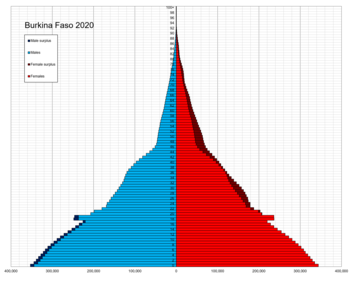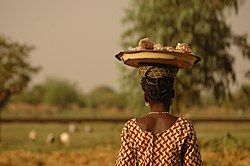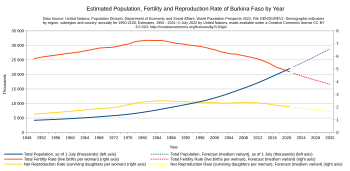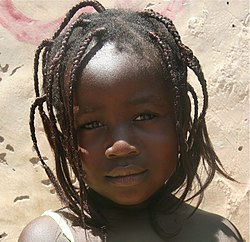| This article needs additional citations for verification. Please help improve this article by adding citations to reliable sources. Unsourced material may be challenged and removed. Find sources: "Demographics of Burkina Faso" – news · newspapers · books · scholar · JSTOR (February 2013) (Learn how and when to remove this message) |
| Demographics of Burkina Faso | |
|---|---|
 Population pyramid of Burkina Faso in 2020 Population pyramid of Burkina Faso in 2020 | |
| Population | 21,935,389 (2022 est.) |
| Growth rate | 2.53% (2022 est.) |
| Birth rate | 33.57 births/1,000 population (2022 est.) |
| Death rate | 7.71 deaths/1,000 population (2022 est.) |
| Life expectancy | 63.44 years |
| • male | 61.63 years |
| • female | 65.31 years |
| Fertility rate | 4.27 children born/woman (2022 est.) |
| Infant mortality rate | 49.42 deaths/1,000 live births |
| Net migration rate | -0.61 migrant(s)/1,000 population (2022 est.) |
| Age structure | |
| 0–14 years | 43.58% |
| 65 and over | 3.16% |
| Sex ratio | |
| Total | 0.96 male(s)/female (2022 est.) |
| At birth | 1.03 male(s)/female |
| Under 15 | 1.03 male(s)/female |
| 65 and over | 0.66 male(s)/female |
| Nationality | |
| Nationality | Burkinabe |
| Major ethnic | Mossi (52%) |
| Language | |
| Official | French |

Burkina Faso's 22.1 million people belong to two major West African cultural groups: the Gur (Voltaic) and the Mandé. The Voltaic are far more numerous and include the Mossi, who make up about one-half of the population. The Mossi claim descent from warriors who migrated to present-day Burkina Faso and established an empire that lasted more than 800 years. Predominantly farmers, the Mossi are still bound by the traditions of the Mogho Naba, who hold court in Ouagadougou.
Most of Burkina Faso's population is concentrated in the south and center of the country, with a population density sometimes exceeding 48 inhabitants per square kilometer (120 inhabitants per square mile). This population density, high for Africa, causes annual migrations of hundreds of thousands of Burkinabé to Ivory Coast and Ghana for seasonal agricultural work. About a third of Burkinabé adhere to traditional African religions. The introduction of Islam to Burkina Faso was initially resisted by the Mossi rulers. Christians, predominantly Roman Catholics, are largely concentrated among the urban elite.
Few Burkinabé have had formal education. Schooling is free but not compulsory, and only about 29% of Burkina's primary school-age children receive a basic education. The University of Ouagadougou, founded in 1974, was the country's first institution of higher education. The Polytechnic University of Bobo-Dioulasso in Bobo-Dioulasso was opened in 1995.

Population
Burkina Faso has a young age structure – the result of declining mortality combined with steady high fertility – and continues to experience rapid population growth, which is putting increasing pressure on the country's limited arable land. More than 65% of the population is under the age of 25, and the population is growing at 3% annually. Mortality rates, especially those of infants and children, have decreased because of improved health care, hygiene, and sanitation, but women continue to have an average of almost 6 children. Even if fertility were substantially reduced, today's large cohort entering their reproductive years would sustain high population growth for the foreseeable future. Only about a third of the population is literate and unemployment is widespread, dampening the economic prospects of Burkina Faso's large working-age population.
According to the United Nations' Population Division, the population was 20,903,000 in 2020, compared to only 4,284,000 in 1950. The proportion of children below the age of 15 in 2020 was 44.4%, 53.2% of the population was between 15 and 65 years of age, while 2.4% was 65 years or older.
| Total population | Population aged 0–14 (%) | Population aged 15–64 (%) | Population aged 65+ (%) | |
|---|---|---|---|---|
| 1950 | 4 284 000 | 40.7 | 57.3 | 2.0 |
| 1955 | 4 517 000 | 41.0 | 56.9 | 2.2 |
| 1960 | 4 829 000 | 41.3 | 56.3 | 2.3 |
| 1965 | 5 175 000 | 42.2 | 55.2 | 2.5 |
| 1970 | 5 625 000 | 43.3 | 53.9 | 2.8 |
| 1975 | 6 155 000 | 44.2 | 52.8 | 3.0 |
| 1980 | 6 823 000 | 45.6 | 51.2 | 3.2 |
| 1985 | 7 728 000 | 46.7 | 50.0 | 3.3 |
| 1990 | 8 811 000 | 47.3 | 49.5 | 3.3 |
| 1995 | 10 090 000 | 47.1 | 49.8 | 3.1 |
| 2000 | 11 608 000 | 46.8 | 50.5 | 2.8 |
| 2005 | 13 422 000 | 46.5 | 50.9 | 2.6 |
| 2010 | 15 605 000 | 46.2 | 51.3 | 2.5 |
| 2015 | 18 111 000 | 45.6 | 52.0 | 2.4 |
| 2020 | 20 903 000 | 44.4 | 53.2 | 2.4 |
Population Estimates by Sex and Age Group (1.VII.2021) (Data refer to national projections.):
| Age Group | Male | Female | Total | % |
|---|---|---|---|---|
| Total | 10 393 241 | 11 116 202 | 21 509 443 | 100 |
| 0–4 | 1 971 908 | 1 860 417 | 3 832 325 | 17.82 |
| 5–9 | 1 646 122 | 1 589 070 | 3 235 192 | 15.04 |
| 10–14 | 1 367 531 | 1 390 910 | 2 758 441 | 12.82 |
| 15–19 | 1 122 566 | 1 204 719 | 2 327 285 | 10.82 |
| 20–24 | 908 843 | 1 033 776 | 1 942 619 | 9.03 |
| 25–29 | 730 372 | 884 547 | 1 614 919 | 7.51 |
| 30–34 | 588 794 | 728 172 | 1 316 966 | 6.12 |
| 35–39 | 468 316 | 586 269 | 1 054 585 | 4.90 |
| 40–44 | 372 345 | 466 984 | 839 329 | 3.90 |
| 45–49 | 300 835 | 370 491 | 671 326 | 3.12 |
| 50–54 | 248 194 | 293 790 | 541 984 | 2.52 |
| 55–59 | 194 917 | 224 363 | 419 280 | 1.95 |
| 60–64 | 149 409 | 164 492 | 313 901 | 1.46 |
| 65–69 | 112 992 | 120 551 | 233 543 | 1.09 |
| 70–74 | 83 974 | 84 008 | 167 982 | 0.78 |
| 75–79 | 60 706 | 51 775 | 112 481 | 0.52 |
| 80+ | 65 417 | 61 868 | 127 285 | 0.59 |
| Age group | Male | Female | Total | Percent |
| 0–14 | 4 985 561 | 4 840 397 | 9 825 958 | 45.68 |
| 15–64 | 5 084 591 | 5 957 603 | 11 042 194 | 51.34 |
| 65+ | 323 089 | 318 202 | 641 291 | 2.98 |
Vital statistics

Registration of vital events is not complete in Burkina Faso. The website Our World in Data prepared the following estimates based on statistics from the Population Department of the United Nations.
| Mid-year population (thousands) | Live births (thousands) | Deaths (thousands) | Natural change (thousands) | Crude birth rate (per 1000) | Crude death rate (per 1000) | Natural change (per 1000) | Total fertility rate (TFR) | Infant mortality (per 1000 live births) | Life expectancy (in years) | |
|---|---|---|---|---|---|---|---|---|---|---|
| 1950 | 4 214 | 184 | 119 | 65 | 43.5 | 28.2 | 15.3 | 5.82 | 170.1 | 33.12 |
| 1951 | 4 262 | 188 | 119 | 68 | 43.9 | 27.9 | 16.0 | 5.87 | 168.9 | 33.38 |
| 1952 | 4 313 | 192 | 121 | 71 | 44.3 | 27.9 | 16.4 | 5.93 | 167.8 | 33.55 |
| 1953 | 4 364 | 195 | 121 | 74 | 44.6 | 27.8 | 16.9 | 5.98 | 166.6 | 33.85 |
| 1954 | 4 417 | 199 | 123 | 76 | 44.9 | 27.7 | 17.2 | 6.01 | 165.2 | 34.13 |
| 1955 | 4 473 | 202 | 124 | 79 | 45.1 | 27.6 | 17.6 | 6.06 | 163.8 | 34.45 |
| 1956 | 4 531 | 206 | 125 | 81 | 45.4 | 27.5 | 17.8 | 6.09 | 162.3 | 34.67 |
| 1957 | 4 591 | 210 | 126 | 83 | 45.5 | 27.4 | 18.1 | 6.13 | 160.8 | 34.97 |
| 1958 | 4 652 | 214 | 128 | 86 | 45.8 | 27.3 | 18.5 | 6.17 | 159.3 | 35.26 |
| 1959 | 4 715 | 218 | 128 | 89 | 46.1 | 27.2 | 18.9 | 6.22 | 157.7 | 35.61 |
| 1960 | 4 783 | 222 | 130 | 92 | 46.3 | 27.1 | 19.2 | 6.25 | 156.2 | 35.87 |
| 1961 | 4 853 | 226 | 131 | 95 | 46.5 | 26.9 | 19.6 | 6.29 | 154.8 | 36.24 |
| 1962 | 4 924 | 231 | 132 | 99 | 46.7 | 26.7 | 20.0 | 6.32 | 153.5 | 36.67 |
| 1963 | 4 999 | 235 | 133 | 102 | 46.9 | 26.5 | 20.4 | 6.36 | 152.4 | 36.97 |
| 1964 | 5 076 | 240 | 134 | 106 | 47.2 | 26.4 | 20.8 | 6.42 | 151.2 | 37.25 |
| 1965 | 5 158 | 245 | 135 | 110 | 47.3 | 26.1 | 21.2 | 6.47 | 150.1 | 37.69 |
| 1966 | 5 243 | 249 | 137 | 113 | 47.5 | 26.0 | 21.5 | 6.53 | 149.1 | 37.92 |
| 1967 | 5 331 | 254 | 138 | 117 | 47.6 | 25.8 | 21.8 | 6.59 | 148.2 | 38.29 |
| 1968 | 5 422 | 260 | 139 | 120 | 47.8 | 25.6 | 22.1 | 6.65 | 147.3 | 38.53 |
| 1969 | 5 516 | 263 | 140 | 123 | 47.6 | 25.4 | 22.2 | 6.66 | 146.6 | 38.86 |
| 1970 | 5 612 | 268 | 141 | 126 | 47.6 | 25.1 | 22.4 | 6.69 | 145.4 | 39.24 |
| 1971 | 5 708 | 272 | 142 | 129 | 47.5 | 24.9 | 22.6 | 6.70 | 144.4 | 39.56 |
| 1972 | 5 805 | 276 | 142 | 134 | 47.5 | 24.5 | 23.0 | 6.72 | 142.6 | 40.05 |
| 1973 | 5 908 | 282 | 143 | 139 | 47.6 | 24.1 | 23.5 | 6.77 | 140.4 | 40.55 |
| 1974 | 6 018 | 288 | 141 | 147 | 47.7 | 23.4 | 24.3 | 6.84 | 137.3 | 41.35 |
| 1975 | 6 138 | 295 | 140 | 155 | 47.9 | 22.7 | 25.2 | 6.91 | 133.6 | 42.31 |
| 1976 | 6 270 | 302 | 138 | 164 | 48.1 | 22.0 | 26.1 | 6.95 | 129.6 | 43.25 |
| 1977 | 6 417 | 312 | 137 | 175 | 48.5 | 21.4 | 27.2 | 7.05 | 125.7 | 44.15 |
| 1978 | 6 578 | 323 | 137 | 186 | 49.0 | 20.7 | 28.3 | 7.15 | 122.1 | 45.07 |
| 1979 | 6 750 | 333 | 136 | 196 | 49.2 | 20.2 | 29.0 | 7.19 | 119.0 | 45.90 |
| 1980 | 6 933 | 341 | 137 | 204 | 49.1 | 19.8 | 29.4 | 7.22 | 116.3 | 46.54 |
| 1981 | 7 124 | 350 | 139 | 211 | 49.1 | 19.5 | 29.5 | 7.26 | 114.4 | 46.87 |
| 1982 | 7 322 | 358 | 139 | 219 | 48.9 | 19.0 | 29.9 | 7.25 | 112.1 | 47.60 |
| 1983 | 7 531 | 367 | 140 | 227 | 48.7 | 18.6 | 30.1 | 7.25 | 110.3 | 48.09 |
| 1984 | 7 751 | 379 | 141 | 238 | 48.8 | 18.2 | 30.6 | 7.25 | 108.5 | 48.64 |
| 1985 | 7 979 | 390 | 143 | 247 | 48.9 | 17.9 | 30.9 | 7.24 | 106.7 | 48.95 |
| 1986 | 8 208 | 398 | 146 | 252 | 48.5 | 17.8 | 30.7 | 7.22 | 104.8 | 49.01 |
| 1987 | 8 435 | 406 | 149 | 257 | 48.0 | 17.7 | 30.4 | 7.17 | 103.1 | 49.06 |
| 1988 | 8 664 | 412 | 152 | 260 | 47.5 | 17.5 | 30.0 | 7.11 | 101.7 | 49.13 |
| 1989 | 8 895 | 419 | 155 | 265 | 47.1 | 17.3 | 29.7 | 7.05 | 100.8 | 49.17 |
| 1990 | 9 131 | 429 | 156 | 272 | 46.8 | 17.1 | 29.8 | 7.01 | 100.2 | 49.44 |
| 1991 | 9 365 | 438 | 160 | 279 | 46.7 | 17.0 | 29.7 | 6.97 | 100.0 | 49.45 |
| 1992 | 9 599 | 447 | 163 | 284 | 46.4 | 16.9 | 29.5 | 6.94 | 99.8 | 49.44 |
| 1993 | 9 840 | 455 | 167 | 288 | 46.2 | 17.0 | 29.2 | 6.89 | 99.7 | 49.21 |
| 1994 | 10 091 | 466 | 170 | 296 | 46.1 | 16.8 | 29.3 | 6.84 | 99.3 | 49.31 |
| 1995 | 10 353 | 478 | 173 | 305 | 46.0 | 16.7 | 29.4 | 6.81 | 98.7 | 49.45 |
| 1996 | 10 621 | 490 | 175 | 314 | 46.0 | 16.5 | 29.5 | 6.78 | 97.6 | 49.61 |
| 1997 | 10 897 | 500 | 180 | 319 | 45.8 | 16.5 | 29.3 | 6.72 | 96.8 | 49.40 |
| 1998 | 11 201 | 510 | 180 | 331 | 45.5 | 16.0 | 29.5 | 6.66 | 95.0 | 49.99 |
| 1999 | 11 534 | 523 | 181 | 342 | 45.3 | 15.7 | 29.6 | 6.59 | 93.6 | 50.33 |
| 2000 | 11 883 | 537 | 182 | 355 | 45.2 | 15.3 | 29.9 | 6.52 | 92.1 | 50.85 |
| 2001 | 12 250 | 549 | 185 | 364 | 44.8 | 15.1 | 29.7 | 6.43 | 90.4 | 51.07 |
| 2002 | 12 632 | 561 | 187 | 374 | 44.5 | 14.8 | 29.6 | 6.34 | 88.8 | 51.27 |
| 2003 | 13 031 | 579 | 188 | 391 | 44.5 | 14.4 | 30.0 | 6.28 | 86.7 | 51.79 |
| 2004 | 13 446 | 595 | 188 | 407 | 44.2 | 14.0 | 30.3 | 6.22 | 84.1 | 52.42 |
| 2005 | 13 876 | 614 | 187 | 426 | 44.2 | 13.5 | 30.7 | 6.18 | 81.3 | 53.09 |
| 2006 | 14 316 | 636 | 187 | 448 | 44.4 | 13.1 | 31.3 | 6.17 | 78.6 | 53.74 |
| 2007 | 14 757 | 652 | 187 | 466 | 44.2 | 12.6 | 31.5 | 6.11 | 75.8 | 54.38 |
| 2008 | 15 198 | 668 | 183 | 485 | 43.9 | 12.0 | 31.9 | 6.05 | 72.7 | 55.34 |
| 2009 | 15 650 | 682 | 182 | 500 | 43.5 | 11.6 | 31.9 | 5.99 | 70.2 | 55.96 |
| 2010 | 16 117 | 697 | 182 | 516 | 43.2 | 11.3 | 32.0 | 5.94 | 67.8 | 56.48 |
| 2011 | 16 603 | 712 | 180 | 531 | 42.8 | 10.8 | 32.0 | 5.87 | 65.5 | 57.13 |
| 2012 | 17 114 | 725 | 180 | 545 | 42.3 | 10.5 | 31.8 | 5.79 | 63.6 | 57.62 |
| 2013 | 17 636 | 736 | 182 | 554 | 41.7 | 10.3 | 31.4 | 5.70 | 61.8 | 57.82 |
| 2014 | 18 170 | 745 | 181 | 564 | 41.0 | 10.0 | 31.0 | 5.60 | 60.0 | 58.36 |
| 2015 | 18 718 | 751 | 180 | 570 | 40.1 | 9.6 | 30.5 | 5.48 | 58.3 | 58.85 |
| 2016 | 19 275 | 751 | 180 | 572 | 39.0 | 9.3 | 29.7 | 5.32 | 56.7 | 59.33 |
| 2017 | 19 836 | 752 | 181 | 571 | 37.9 | 9.1 | 28.8 | 5.16 | 55.0 | 59.54 |
| 2018 | 20 393 | 761 | 180 | 581 | 37.3 | 8.8 | 28.5 | 5.07 | 53.5 | 60.05 |
| 2019 | 20 962 | 720 | 180 | 540 | 34.3 | 8.6 | 25.8 | 4.68 | 58.7 | 60.2 |
| 2020 | 21 479 | 703 | 179 | 524 | 32.7 | 8.3 | 24.4 | 4.44 | 57.0 | 60,5 |
| 2021 | 21 995 | 713 | 186 | 527 | 32.4 | 8.4 | 24.0 | 4.36 | 55.3 | 60.0 |
| 2022 | 22 509 | 721 | 183 | 538 | 32.0 | 8.1 | 23.9 | 4.28 | 53.8 | 60.7 |
| 2023 | 23 026 | 729 | 183 | 545 | 31.6 | 8.0 | 23.7 | 4.28 | 52.3 | 61.1 |
| Graphs are unavailable due to technical issues. Updates on reimplementing the Graph extension, which will be known as the Chart extension, can be found on Phabricator and on MediaWiki.org. |
| Graphs are unavailable due to technical issues. Updates on reimplementing the Graph extension, which will be known as the Chart extension, can be found on Phabricator and on MediaWiki.org. |
| Graphs are unavailable due to technical issues. Updates on reimplementing the Graph extension, which will be known as the Chart extension, can be found on Phabricator and on MediaWiki.org. |
| Graphs are unavailable due to technical issues. Updates on reimplementing the Graph extension, which will be known as the Chart extension, can be found on Phabricator and on MediaWiki.org. |
Demographic and Health Surveys
Total Fertility Rate (TFR) (Wanted Fertility Rate) and Crude Birth Rate (CBR):
| Year | CBR (Total) | TFR (Total) | CBR (Urban) | TFR (Urban) | CBR (Rural) | TFR (Rural) |
|---|---|---|---|---|---|---|
| 1993 | 43.0 | 6.9 (6.0) | 39.0 | 5.0 (3.9) | 43.0 | 7.3 (6.5) |
| 1998–99 | 45.1 | 6.8 (6.0) | 32.6 | 4.1 (3.4) | 47.0 | 7.3 (6.5) |
| 2003 | 42.6 | 6.2 (5.4) | 32.4 | 3.7 (3.2) | 44.5 | 6.9 (6.0) |
| 2010 | 41.2 | 6.0 (5.2) | 33.3 | 3.9 (3.3) | 43.3 | 6.7 (5.9) |
| 2014 | 38.6 | 5.5 | 33.6 | 4.0 | 40.2 | 6.1 |
| 2017-18 | 35.1 | 5.2 | 30.9 | 3.7 | 36.1 | 5.6 |
| 2021 | 30.7 | 4.4 (4.2) | 28.4 | 3.4 (3.3) | 31.6 | 4.9 (4.6) |
Fertility data as of 2013 (DHS Program):
| Region | Total fertility rate | Percentage of women age 15-49 currently pregnant | Mean number of children ever born to women age 40–49 |
|---|---|---|---|
| Centre | 3.7 | 6.8 | 5.3 |
| Boucle du Mouhoun | 6.8 | 10.8 | 7.1 |
| Cascades | 6.0 | 10.4 | 7.0 |
| Centre-Est | 6.3 | 8.1 | 6.6 |
| Centre-Nord | 6.7 | 10.7 | 7.1 |
| Centre-Ouest | 6.4 | 10.4 | 7.1 |
| Centre-Sud | 5.6 | 9.4 | 6.8 |
| Est | 7.5 | 15.0 | 7.9 |
| Hauts Bassins | 5.2 | 9.3 | 5.9 |
| Nord | 6.2 | 10.3 | 7.0 |
| Plateau Central | 5.8 | 9.4 | 6.8 |
| Sahel | 7.5 | 12.9 | 7.6 |
| Sud-ouest | 6.4 | 10.8 | 7.1 |
Life expectancy at birth

- total population: 63.44 years
- male: 61.63 years
- female: 65.31 years (2022 est.)
- Total population: 63.06 years
- Male: 61.28 years
- Female: 64.89 years (2021 est.)
Ethnic groups


- Mossi 53.7%, Fulani (Peuhl) 6.8%, Gurunsi 5.9%, Bissa 5.4%, Gurma 5.2%, Bobo 3.4%, Senufo 2.2%, Bissa 1.5%, Lobi 1.5%, Tuareg/Bella 0.1%, other 12.8%, foreign 0.7% (2021 est.)
Languages
Further information: Languages of Burkina Faso- French(official), native African languages belonging to Sudanic family spoken by 90% of the population
Religion
Main article: Religion in Burkina FasoReligion in Burkina Faso (2017-2018)
Islam (63.2%) Roman Catholic (24.6%) Protestant (6.9%) Animism (4.2%) Other and none (1.1%)- Islam 61.5%, Roman Catholic 23.3%, Traditional/Animist 7.8%, Protestant 6.5%, Other/No Answer 0.2%, None 0.7% (2010 est.)
References
- ^ "Population Division of the Department of Economic and Social Affairs of the United Nations Secretariat, World Population Prospects: Data Query". Esa.un.org. Retrieved 2021-01-31.
- "UNSD — Demographic and Social Statistics".
- "Population & Demography Data Explorer". Our World in Data. Retrieved 2022-07-22.
- "Enquête Démographique et de Santé 1993" (PDF). Dhsprogram.com. Archived (PDF) from the original on 2022-10-09. Retrieved 2017-08-27.
- "Enquête Démographique et de Santé 1998-99" (PDF). Dhsprogram.com. Archived (PDF) from the original on 2022-10-09. Retrieved 2017-08-27.
- "Enquête Démographique et de Santé 2003" (PDF). Dhsprogram.com. Archived (PDF) from the original on 2022-10-09. Retrieved 2017-08-27.
- "Enquête Démographique et de Santé 2010" (PDF). Dhsprogram.com. Archived (PDF) from the original on 2022-10-09. Retrieved 2017-08-27.
- "STATcompiler". www.statcompiler.com. Retrieved 2020-02-17.
- "Burkina Faso: Enquête Démographique et de Santé 2021" (PDF). DHS Program (in French). Archived (PDF) from the original on 2022-10-09.
- "Nigeria Demographic and Health Survey 2013" (PDF). Dhsprogram.com. Archived (PDF) from the original on 2022-10-09. Retrieved 2017-08-27.
- "Burkina Faso - World Factbook Glyph".
- "Burkina Faso Religions - Demographics".
Attribution:
 This article incorporates public domain material from The World Factbook. CIA.
This article incorporates public domain material from The World Factbook. CIA.
External links
- (in French) Institut National de la Statistique et de la Démographie Archived 2016-01-05 at the Wayback Machine
| Ethnic groups in Burkina Faso | |
|---|---|
| Demographics of Africa | |
|---|---|
| Sovereign states |
|
| States with limited recognition | |
| Dependencies and other territories |
|
| Burkina Faso articles | |||||
|---|---|---|---|---|---|
| History |  | ||||
| Geography | |||||
| Politics | |||||
| Economy | |||||
| Culture |
| ||||